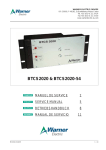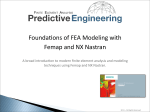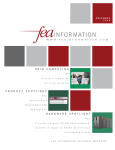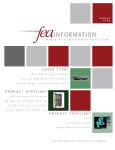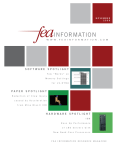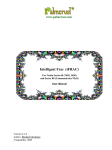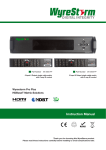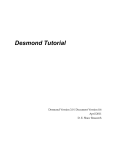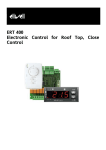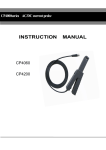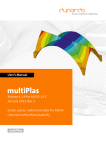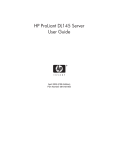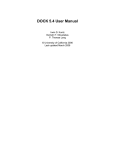Download FeaInformation
Transcript
e u s s I y r a s r e v i n TH A n 6 O C T O B E R 2 0 0 6 I N F O R M AT I O N W W W . F E A I N F O R M A T I O N . C O M PRODUCT S P O T L I G H T I n t er f a c i n g Wo r k b e n c h A N A LY S I S L S - D Y N A ® SPOTLIGHT P R E D I C T I V E E N G I N E E R I N G E x t r e m e N on l i n e a r o f a n d A N S Y S P l a s t i c I m p l i c i t A n a l y s i s T h r e a d D e s i g n H A R D WA R E S P O T L I G H T I n f i n i Pa t h ™ I n t e r c o n n e c t U N I Q U E I n f i n i B a n d ™ B U I LT O N A H Y P E R M E S S A G I N G A R C H I T E C T U R E ™ F E A I N F O R M AT I O N R E S O U R C E M A G A Z I N E FeaInformation.com 1 FEA Information Worldwide Participants Contents 01 02 03 05 07 08 09 14 16 18 19 20 21 22 28 29 31 32 33 35 36 37 Index FEA Announcements LS-DYNA: Extreme Implicit Nonlinear Analysis of Plastic Thread Design ANSYS: Interfacing ANSYS Workbench and LS-DYNA HP Benchmark Results on Top Crunch LS-PrePost Yahoo Yammerings Intel: Parintins Is An Island in the Amazon Qlogic: Interconnect Built On A Unique Hypermessaging Architecture Publication A Coupled Thermal and Mechanical Model of Sliding Wear FEA Weekly News Page – September Highlights LSTC Training Classes EVENTS LS-DYNA Resource Page Hardware & Computing and Communication Products Software Distributors Consulting and Engineering Services Educational & Contributing Participants China Participants Informational Websites 6th European LS-DYNA Conference SGI: Whatever Your Environment. There’s and SGI server that can keep your data moving Editor: Trent Eggleston Managing Editor: Marsha Victory Technical Editor: Art Shapiro Graphic Designer: Wayne L. Mindle Technical Writers: Dr. David Benson Uli Franz Dr. Ala Tabiei Suri Bala Technical Consultants: Steve Pilz Reza Sadeghi FeaInformation.com FEA Information Announcements Our 6th Anniversary Celebrating our Anniversary: October marks our 6th year Anniversary. Our first edition was published October 2000 and can be found archived on FEA Publications – sidebar link “FEA News” We would like to thank all of our participants, writers, contributors and the worldwide community of engineers for making this publication and websites a success. TRAVEL: October 25-27 Marsha Victory, will be attending: 2006 CADFEM Users Meeting International Congress on FEM Technology - Stuttgart area - Germany If you are attending please make time to say hello. Sincerely, Trent Eggleston & Marsha Victory The content of this publication is deemed to be accurate and complete. However, FEA Information Inc. doesn’t guarantee or warranty accuracy or completeness of the material contained herein. All trademarks are the property of their respective owners. This publication is published for FEA Information Inc., copyright 2006. All rights reserved. Not to be reproduced in hardcopy or electronic copy. Note: All reprinted full articles, excerpts, notations, and other matter are reprinted with permission and full copyright remains with the original author or company designated in the copyright notice 2 FeaInformation.com 3 Extreme Implicit Nonlinear Analysis of Plastic Thread Design All analysis work was done with LS-DYNA V971. © Copyright George Laird, Predictive Engineering, Predictive Engineering The genesis of this project came about to validate a prior consultant's work indicating that the thread design of a new device would fail exactly at the design load of the instrument. Since the company had experimental data which strongly indicated a failure load of 2x the design load there was a whirlwind of debate as to whether to proceed to mass production or conduct an extensive redesign campaign. Although I entered this project with high confidence I soon realized what a quagmire I had entered. Initially I thought the analysis work could be accomplished using a standard implicit nonlinear code and after a few days of frustrating keyboard pounding I soon realized that I needed more horsepower. I was against the wall and it was time to pull out the big guns: LS-DYNA. Initially I was a bit hesitant to use LS-DYNA since I wanted to maintain the analysis procedure within the implicit world and historically LS-DYNA was a bit weak on the implicit side. Well, welcome to 2005 and V971 of LS-DYNA. Based on my experience with this project and prior experiences, I can clearly state that LS-DYNA has made great strides in the implicit realm. That is to say, LSDYNA has always been dominant on the explicit side while its implicit capabilities were considered more of a sub-set. original consultant's work. This was depressing since the experimental work indicated a 2x load factor and I knew that LS-DYNA could do better. Digging in and making several calls to the technical support staff at LSTC, a recommendation was made to use *MAT PLASTICITY COMPRESSION TENSION (*MAT 124) along with several other tweaks to the implicit solver routine. The utility of this material model is that one can use different stress/strain curves and failure limits for compression and tension. This was absolutely fantastic for the plastic material used for the thread design since the failure stress for the plastic under compression is about 3x higher than that for tension. With these changes in place, the LS-DYNA model predicted a failure load of 2x the design load. This was very gratifying since the material stress/strain curves were not "adjusted" and were used straight out of the gate. At the end of this project, the client was able to rest assured that the design was robust and we also learned many other cool things about plastic thread design, but they are of course, proprietary. Initially, the LS-DYNA results for the thread design matched up with the FeaInformation.com 4 capture the mechanical response of the device. The model was carefully meshed to obtain a fine grid of 8-node brick elements. Contact elements and other analysis specific tweaks were done within LSTC’s LSPOST (a pre- and post-processor for LS-DYNA). A complete implicit analysis run would take about 5 minutes on a standard single-processor Intel PC. Modeling Notes: The 3-D geometry was provided in the form of a Pro/E STEP file and imported directly into Femap V9.0.1. The model exploited the geometric and loading symmetry of the structure and only a 5 degree segment was required to The material model was *MAT 124 and data was derived from tensile test data provided by the client. Compression test data were inferred from theory and general data trends for this material. The model was run to the failure point of the plastic. Predictive Engineering is a mechanical engineering consulting company specializing in finite element analysis (FEA). Under this banner, a broad range of capabilities are brought to bear in developing predictive engineering models via expertise in thermal/fluids (CFdesign), drop-testing and impact analysis (LS-DYNA), and static/dynamic/nonlinear/thermal structural analysis software FeaInformation.com 5 Interfacing ANSYS Workbench and LS-DYNA® © CADFEM GmbH - Dr.-Ing. Matthias Hoermann ANSYS Workbench enables users to solve the most diverse analysis tasks in the same standard user interface. The new interface “Workbench LS-DYNA” developed by CADFEM gives users access to LS-DYNA®´s unique highly dynamic, nonlinear analysis capabilities within the Workbench environment. Numerical Simulations as integral part in the virtual product development process exhibit a huge spectrum. Ranging from simple modal analyses over linear and nonlinear stiffness and strength based problems up to coupled multiphysic analyses, where different physical disciplines interact with each other. Since they complement each other so well, ANSYS Workbench and LS-DYNA deliver unrivaled excellence in covering a huge number of current FEM simulation tasks. ANSYS Workbench ANSYS Workbench is a simulation platform that enables users to perform more product development tasks faster. With the Workbench environment, ANSYS took a quantum leap into model analysis and handling different simulation disciplines. Besides structural and fluid mechanics tasks, it can also process coupled phenomena (“Multiphysics”) such as electromagnetic thermal-mechanical effects and fluid-structure interaction in the same standard user interface. Besides its multi-tasking features, ANSYS Workbench also boasts seamless model file transfer from and to almost all common 3D CAD systems. It also handles assemblies with automatic mesh generation and automatic contact detection efficiently. LS-DYNA LS-DYNA is extremely strong in areas where large, non-linear issues and shorttime dynamics are relevant. In product development, the demand for transient, strongly non-linear analyses, e.g. drop tests, buckling and load limit analyses, is rising strongly. A complex contact definition, coupled with high frequency, time transient stress wave propagation in the component, is of vital importance in virtual drop testing. Furthermore, dealing with load limit analyses requires large element deformations and corresponding non-linear material models, taking into account damage to the material with subsequent failure, too. Interface “Workbench LS-DYNA” An interface between ANSYS Workbench and LS-DYNA provides the opportunity to combine both programs. The German ANSYS and LS-DYNA distributor CADFEM GmbH has thus created a unidirectional, interactive graphic interface for the transfer of data from ANSYS Workbench to LSDYNA. This not only enables users to transfer the pure structure in form of nodes and elements, but sections, materials, contact definitions and boundary conditions, including prescribed motions and force loading, too. LS-DYNA specific control and database options will be included from a template file, which can be customized by the user. FeaInformation.com 6 Advantages for LS-DYNA users LS-DYNA users will benefit from this interface. With an existing ANSYS Workbench license and LSTC’s free of charge LSPrePost an additional preprocessor causing cost and training effort may no longer be necessary. The interface also enables easier data exchange with other analysis departments which are already using ANSYS Workbench. Moreover the CAD interfaces in ANSYS Workbench also allow a closer link to the construction departments. Interface “Workbench LS-DYNA” on the CADFEM Users’ Meeting 2006 The interface will be presented during a two hour, afternoon workshop on Wednesday, October 25th at the 2006 CADFEM Users’ Meeting to take place in Stuttgart, Germany from October 25th to 27th, 2006. Additionally, the meeting will provide in-depth information about new features and developments LS-DYNA and LS-PrePost, featuring speakers including Dr. John Hallquist. (www.usersmeeting.com) More information: CADFEM GmbH Dr.-Ing. Matthias Hoermann Phone +49-8092-7005-41 E-Mail [email protected] www.cadfem.de FeaInformation.com 7 TOP CRUNCH News – LS-DYNA Benchmarks Online Dr. David Benson – www.topcrunch.org FEA Information Participant – HP Posted 10/12/2006 HP/HP Opteron CP4000/InfiniBand AMD Dualcore Opteron 2.6 GHz DL145 64 x 2 x 1 = 128 2624 3 Vehicle Collision HP/HP Opteron CP4000/InfiniBand AMD Dualcore Opteron 2.6 GHz DL145 32 x 2 x 2 = 128 3257 3 Vehicle Collision HP/HP Opteron CP4000/InfiniBand AMD Dualcore Opteron 2.6 GHz DL145 32 x 2 x 1 = 64 3797 3 Vehicle Collision HP/HP Opteron CP4000/InfiniBand AMD Dualcore Opteron 2.6 GHz DL145 16 x 2 x 2 = 64 4236 3 Vehicle Collision HP/HP Opteron CP4000/InfiniBand AMD Dualcore Opteron 2.6 GHz DL145 24 x 2 x 1 = 48 4383 3 Vehicle Collision HP/HP Opteron CP4000/InfiniBand AMD Dualcore Opteron 2.6 GHz DL145 12 x 2 x 2 = 48 5038 3 Vehicle Collision HP/HP Opteron CP4000/InfiniBand AMD Dualcore Opteron 2.6 GHz DL145 16 x 2 x 1 = 32 5883 3 Vehicle Collision HP/HP Opteron CP4000/InfiniBand AMD Dualcore Opteron 2.6 GHz DL145 8 x 2 x 2 = 32 6902 3 Vehicle Collision HP/HP Opteron CP4000/InfiniBand AMD Dualcore Opteron 2.6 GHz DL145 12 x 2 x 1 = 24 7346 3 Vehicle Collision HP/HP Opteron CP4000/InfiniBand AMD Dualcore Opteron 2.6 GHz DL145 6 x 2 x 2 = 24 8451 3 Vehicle Collision HP/HP Opteron CP4000/InfiniBand AMD Dualcore Opteron 2.6 GHz DL145 8 x 2 x 1 = 16 10402 3 Vehicle Collision HP/HP Opteron CP4000/InfiniBand AMD Dualcore Opteron 2.6 GHz DL145 4 x 2 x 2 = 16 12031 3 Vehicle Collision HP/HP Opteron CP4000/InfiniBand AMD Dualcore Opteron 2.6 GHz DL145 4x2x1=8 19111 3 Vehicle Collision HP/HP Opteron CP4000/InfiniBand AMD Dualcore Opteron 2.6 GHz DL145 2x2x2=8 22259 3 Vehicle Collision HP/HP Opteron CP4000/InfiniBand AMD Dualcore Opteron 2.6 GHz DL145 2x2x1=4 36505 3 Vehicle Collision HP/HP Opteron CP4000/InfiniBand AMD Dualcore Opteron 2.6 GHz DL145 1x2x2=4 42852 3 Vehicle Collision HP/HP Opteron CP4000/InfiniBand AMD Dualcore Opteron 2.6 GHz DL145 1x2x1=2 72477 3 Vehicle Collision FeaInformation.com 8 LS-PrePost® Online Documentation News Update www.lstc.com/lspp © Copyright LSTC This online documentation site is provided by the developers of LS-PrePost and is continually updated. LS-PrePost, as well as LS-OPT are delivered with LS-DYNA at no additional fees. LS-PrePost is an advanced pre and post-processor. The user interface is designed to be both efficient and intuitive. LS-PrePost runs on Windows, Linux, and Unix utilizing OpenGL graphics to achieve fast rendering and XY plotting. 16-Oct Tutorial 11 added to online documentation 12-Oct Tutorial 10 added to online documentation 11-Oct Update of nLMesh Interface 10-Oct Added QuickBeam option to ElEdit Interface to allow convenient creation of 2-noded beams 09-Oct Added Direction option to ElEdit Interface to modify element orientation 04-Oct Major update to the form and functionality of the LS-PrePost Google Group 21-Sep Tutorial 9 added to online documentation 20-Sep Enabled pre-filtering for HIC/CSI calculations using the ASCII Interface 19-Sep Enabled Function Keys for panel navigation and command file execution 11-Sep Added search function (powered by Google) FeaInformation.com 9 Yahoo Group Yammerings Note: LS-DYNA Yahoo Group is neither owned nor operated by LSTC, and LSTC does not control the content. Jim Kennedy KBS2 Inc. [email protected] Len Schwer Schwer Engineering & Consulting Services [email protected] The LS-DYNA Yahoo Group archives contains a wealth of information that can be helpful to any LS-DYNA user. We suggest you review the archives when you are seeking help on any topic related to LS-DYNA. This installment of “Yahoo Yammerings” features five questions, with responses, from the past month of postings to the LS-DYNA Yahoo Group. 1. 2. 3. 4. 5. Nodal Acceleration Result? Converting solid elements to SPH nodes? Negative volume problem? Apply load in cylindrical co-ordinate system? Concrete Erosion? Question: Nodal Acceleration Result? I am performing a drop simulation and measurement. I found that the nodal acceleration is much larger than measurement result. But dv/dt is close to the measurement data. I have 2 questions: 1) Is the acceleration result from LS-DYNA reliable? If I need to read the nodal acceleration result, which value I should get, acceleration or dv/dt? 2) What the difference between acceleration and dv/dt? I know it has different physical meaning, but I can't explain it exactly. Reply by Denis Corkery The usual recommendation is that you use the dv/dt rather then reading accelerations directly. I think the reason for this is that the nodal accelerations are calculated based on the central difference method which averages the nodal accelerations between output intervals. This will result in an artificially smoothed acceleration trace due to the averaging that has taken place. The dv/dt should be more representative as it converts the nodal velocities directly at each output interval. It is also recommended that the frequency rate of the simulation data matches that of the sampling rate of the test instrumentation (typically 10kHz) for a fair comparison to be made. Reply by Len Schwer A quick search of the Yahoo Groups archives (does anyone other than Jim Kennedy & me look in the archives?) produced this cogent posting (#1167) on 6 Dec 02: FeaInformation.com 10 ---------If you output the velocities and accelerations at EVERY time step AND use the *Current Time Step Size*, then the central difference operator applied to the time-centered velocities will give the acceleration, as that is EXACTLY (the inverse of) how they are calculated in LS-DYNA In LS-DYNA the accelerations are integrated to give the time-centered velocities using the central difference operator. Now if you output at some regular time interval and use the average time step, you will NOT get the acceleration from differencing the velocity, because that is NOT how the accelerations are calculated. This is the typical NODOUT file process. The computed LS-DYNA acceleration histories are usually very noisy, so even small errors in user integration (velocity differentiation) will produces different results. To compare computed and measured acceleration records, Filtering and NOT smoothing should be used on the computed accelerations, in a manner similar to how the measured accelerations were filtered; all accelerometers are frequency limited and typical signal conditioners further filter the measurements. ---------------Question: Converting solid elements to SPH nodes? I wonder if there is any kind of application or file to transform a solid element mesh into SPH nodes format? When you want to use SPH nodes, first you need to make a solid mesh, and I would like to know if there is any way to transform that mesh into SPH in an easy way. I use FEMB to create the solid mesh, but my version does not have an option to transform solid elements into SPH nodes. I would like someone to tell me if there is any application, or if someone could share any file to do that transformation. Reply by Len Schwer I think you will need to write your own script/program to perform this task. LS-PrePost does have a Hex-to-SPH feature (on Page 7) but I cannot figure out how it works and the “documentation” leaves something to be desired: http://www.lstc.com/lspp/content/pages/7/sphgen/sphgen.shtml If you write your own script/program, the only challenge is to compute the volume of the standard hexahedral elements so you can calculate the mass to be partitioned to the SPH particles. Follow-up Reply by Akram Abu-Odeh A little test I had with LS-PrePost (LSPP) and SPH. First step is to input a model with at least a single solid elements part and a material defined. FeaInformation.com 11 Go Page 7 and click on SphGen. On the “Primary Controls” buttons use the FromHeX as Len mentioned. You should see a list of Part(s) in a square down on the “Secondary Controls” panel. Click on the Part that you want to convert to SPH. The field that is prefixed with “From” should have your part # now. Then you need to type in the new part # you want for the SPH part. Or just click “New ID” button and it will give you the next available part number. You have to assign a material to it. Although you are using an exiting part, LSPP wants you to define the material for the SPH part. So, click on the button “>>” next to the Mat ID label and you will be presented with a material link dialog of the material types available in the model. Choose one (material type, there is no material ID in here) and click “Edit” and once you get the material “keyword input” dialog choose the material ID you want and click “Accept” and then "Done" and then another “Done” on the Material Link. You should by now have the “Apply” button active. Press the “Apply” and your original part will disappear. But if you go to Page 1 and “SelPar,” you should get a new part in there select it and your particles should be on the screen. It did not work for me the first time although I created the model in LSPP. But after saving it, quitting LSPP, starting LSPP again, reading the model back into LSPP, it worked! Question: Negative volume problem? I am running an analysis of circular cables. These cables are welded on top and bottom to two beams. I have meshed the cables with solid 8-noded elements and the material for the cables is *Mat_Piecewise_Linear_Plasticity, steel with density of 5.87e-09 and young's modulus of 205000. The units used are mm and N. I have given the load for the nodes at the middle of 3 cables. Now when I try to run the analysis, it is error terminating with negative volume problems in the elements of circular cables. Reply by Len Schwer In my experience the most likely cause of negative volumes is due to concentrated (point) forces or contacts that result in point forces. I suggest you search the archives of this group as this topic comes up frequently, e.g. see Message #9415 posted 12 Apr 06. Question: Apply load in cylindrical co-ordinate system? I would like to know how to create a cylindrical coordinate system in LS-DYNA and apply some load in that system and get results in that coordinate system. Reply by Jim Kennedy To the best of my knowledge, LS-DYNA does not have a cylindrical coordinate system option. LS-DYNA expects Cartesian coordinate systems. The exception is the 2D axisymmetric FeaInformation.com 12 analysis options. If you are interested in using one of the axisymmetric options, I suggest that you look at Remark 3 on page 19.20 of the LS-DYNA Version 970 User's Manual. Follow-up Question Thanks for your help. If I created a material co-ordinate system, is it possible to see results in material co-ordinate system, i.e. I would like to know results of hoop stress and tangential stress values in my analysis? Follow-up Reply by Jim Kennedy I believe that you will find that only the orthotropic and anisotropic materials can be output in their own local material coordinate system. Please see the CMPFLG flag on the *DATABASE_BINARY keyword on Page 9.21 of the LSDYNA Version 970 User’s Manual. At the following LS-DYNA manuals download website: http://www.cadfem.de/Manuals.1323.0.html you will find are three different LS-PrePost User’s manuals. I believe the information for viewing the material axes orientation is given on Pages 11 and 12 of the latest manual (link given here): http://www.cadfem.de/fileadmin/files/lsdyna/website/pdf/pdf_lsprepost/lspp_may_2\005.p df The following is part of a message (#9394 posted April 7, 2006) where I provided an answer to a similar question. Perhaps this may be of interest and/or help: Yes, it is possible to orientate materials following a specified material coordinate direction. Please do not confuse the nodal/element coordinate systems with the material coordinate systems where anisotropic and orthotropic material behavior can be addressed through material parameters and local or global material axes. I believe there is a large selection of materials that offer either anisotropic and or orthotropic material behavior. Among these are: MAT_002, MAT_037, MAT_099, MAT_128, MAT_021, MAT_022, MAT_023, MAT_026, MAT_033, MAT_034, MAT_036, MAT_039, MAT_040, MAT_054-55, MAT_058, MAT_059, MAT_81-82, MAT_086, MAT_103, MAT_104, MAT_116, MAT_117, MAT_122, MAT_122, MAT_126, MAT_130, MAT_142, MAT_143, MAT_161-162, MAT_179 I did observe that one of the material axes option, AOPT=4 offers an option that may be of interest: FeaInformation.com 13 “EQ.4.0: locally orthotropic in cylindrical coordinate system with the material axis determined by a vector v, and an originating point, P, which define the centerline axis. This option is for solid elements only.” Question: Concrete Erosion? Would anyone like to share his experience in using *MAT_ADD_EROSION to simulate concrete cracking under compression? Since there are multiple failure criteria in *MAT_ADD_EODSION, e.g. MXPRES, MNPEPS, EPSP1, etc., which input controls the concrete’s compressive failure? Are there any input samples available? Reply by Len Schwer Concrete’s compressive failure is controlled by the constitutive model’s shear failure surface. Typically, the only time to use *MAT_ADD_EROSION is when you want to remove elements from a calculation, e.g. during a penetration simulation. I do not think *MAT_ADD_EROSION can be used to simulate the physical cracking that occurs during compression, unless you have a very fine mesh with element sizes on the order of the crack width. If you want to try *MAT_ADD_EROSION criteria, I suggest the strain criteria, as the stress is already limited by the shear failure surface. For cracks, I would think a maximum principal strain criteria would be the first thing to try. You might also have a look at MAT084-085 *MAT_WINFRITH_CONCRETE which generates an additional binary file with crack location, direction, and widths. LS-DYNA Yahoo Groups: There are over 1950 subscribers from all over the world, and this list seems to grow by a hundred new subscribers ever few months; no small testament to the rapidly growing popularity of LS-DYNA. The group currently averages about 200 message per month, i.e. about 7 message per day. You can subscribe to the group by sending an email request to [email protected] or by visiting the Yahoo Groups web site http://groups.yahoo.com Generally, the quickest/best responses are to those questions posed with the most specifics. General questions such as “How do I use XXX feature?” either go unanswered, or are answered by Jim Kennedy with links to appropriate references in the growing LS-DYNA related literature, e.g. see the archive of LS-DYNA Conference proceedings at www.dynalook.com FeaInformation.com 14 October’s Chosen Press Release Parintins Is An Island in the Amazon Intel Chairman Unveils The World’s Most Remote Digital City Amazon Effort Marks Global Movement to Bring Technology to the Next Billion People PARINTINS, Brazil, Sept. 20, 2006 In one of the most remote inhabited places on Earth, the Amazon, Intel Corporation has created a wireless, high-speed Internet network for residents to access vast resources of medical, educational and commercial knowledge through computers. The project is part of the Intel World Ahead Program, an initiative in which Intel plans to invest more than $US 1 billion globally over the next 5 years to accelerate access to computers, the Internet and technology for people in developing communities. The digital transformation of Parintins, a town on an island in the Amazon River, is expected to improve the healthcare and education of its 114,000 residents and advance the lives of future generations. “Technology has expanded what is possible in Parintins,” said Intel Chairman Craig Barrett at a dedication ceremony today in the Amazon rain forest. “It is now a place where wireless broadband links to the Internet bring the expertise of specialists, sophisticated medical imaging and the world’s libraries to a community reachable only by airplane or boat.” Working with the Brazilian government and business and education officials, Intel and its collaborators installed a state-ofthe-art WiMAX network for a primary healthcare center, two public schools, a community center and Amazon University. Intel also donated and installed telemedi- cine equipment at the health center and computer labs at the two schools where students and teachers can regularly connect to the outside world for the first time. “We’ve been blessed with this project,” said Parintins Mayor Frank Bi Garcia. “We’re really isolated and don’t have the conditions to receive the Internet with cables. So we’re receiving it wireless, from antennas, from satellites – access to wireless Internet is a great pleasure for us. This project will prepare this generation for the future.” Intel led the effort in the island city on the Amazon River with support from Cisco, CPqD, Embratel, Proxim and the Bradesco Foundation, as well as Amazonas State University, Amazonas Federal University and São Paulo University. Intel aims to extend wireless PC access to millions of citizens in Latin America and train more than a million teachers about the effective use of technology in the classroom. In Parintins, Intel has already trained 24 teachers through its education initiatives. The Intel® Teach Program teaches teachers how to use technology to improve the way students learn. The Intel® Learn Program provides jobreadiness skills to underprivileged students between the ages of 10 and 18. FeaInformation.com “The student, from the moment he gets in touch with other people, other cultures, with other information beyond the borders of his country, he gets a lot of benefits,” said Goncala Do Nacimento Pinto Filha, a fifth grade teacher in Parintins. “The community can keep up with evolution. It can feel equal in social terms as well.” As part of Parintins’ digital makeover, Amazon University is starting a telemedicine program developed jointly with the medical school of Sao Paulo University. The new capabilities – including real-time, video interaction between specialists and patients hundreds of miles apart – give the town’s 32 doctors faster and greater access to the latest medical data or second opinions. “Telemedicine for us is like a new weapon, a weapon from the future,” said Dr. Gregorz Maciejewski, municipal secretary of Health in Parintins. Doctors say telemedicine will also help in preventing the spread of such diseases as AIDS and leprosy. 15 The solution in the Amazon is to be followed by others planned by Intel for isolated communities in Africa, Asia and the Middle East, where electricity and telecommunications are unreliable or antiquated and transportation is difficult. The wireless infrastructure includes shortrange Wi-Fi radio transmissions and WiMAX, which has an extended transmitting range of up to 30 miles. WiMAX is designed to be a less costly and more efficient way to build wireless computing and communications networks for broadband access. Intel, the world’s largest chip maker, is also a leading manufacturer of computer, networking and communications products. Additional information about Intel is available at www.intel.com/pressroom and at the Amazon Press Kit. Intel, the Intel logo, Viiv, Centrino and vPro are trademarks or registered trademarks of Intel Corporation or its subsidiaries in the United States and other countries. * Other names and brands may be claimed as the property of others. FeaInformation.com 16 Webpage Informational Excerpt InfiniPath™ InfiniBand™ Interconnect BUILT ON A UNIQUE HYPERMESSAGING ARCHITECTURE™ Complete information can be found at: http://www.qlogic.com/products/Infini_Interconnect.asp The InfiniPath family of adapters & ASICs deliver industry-leading performance in a cluster interconnect, allowing organizations to gain maximum performance advantage and return from their investment in clustered systems. InfiniPath yields the lowest latency, the highest message rate and highest effective bandwidth of any cluster or storage interconnect available. As a result, organizations relying on clustered systems for critical computing tasks will gain a significant increase in productivity. The InfiniPath HyperMessaging Architecture™ is the key to the InfiniPath performance advantage, delivering the highest message rate and highest effective bandwidth of any cluster interconnect available. It allows InfiniPath to support over 10 million messages per second, or 10X-MR. By achieving 10X-MR, InfiniPath delivers over 10 times more messages per second than any other cluster interconnect. Its unprecedented messaging rate also reduces network fabric congestion as the InfiniBand adapter will no longer be the network bottleneck InfiniPath Performance Summary: • The world's most scalable and efficient cluster interconnect o 1.29 Microseconds MPI Latency (0-byte, 1/2 round trip) o 88 byte message size to achieve 1/2 of peak bandwidth (streaming, 8 CPU cores) o o o 954 MB/s peak unidirectional bandwidth (streaming) 583 MB/s TCP/IP throughput with 6.7 microsecond latency 11.3 million messages/sec (eight CPU cores per adapter) (Note: Performance measurements obtained using InfiniPath HTX Adapter. Complete info on InfiniPath performance can be found here.) InfiniPath also delivers industry-leading OpenIB performance, allowing applications using OpenIB protocols, such as IPoIB and SDP to achieve maximum scalability. OpenIB was developed by the OpenIB Alliance, now called the Open Fabrics Alliance, an industry association chartered to deliver a single, open-source software stack for deploying InfiniBand solutions. The Open Fabrics Alliance, founded in June 2004, is comprised of leading computer-technology vendors and end-user organizations. It provides a single, open-source standard that ensures interoperability between software stacks and hardware products. FeaInformation.com Based on a suite of industry standards, InfiniPath achieves world class performance at a commodity price structure, utilizing standard InfiniBand switching fabrics. With the InfiniPath interconnect, applications deployed on Linux clusters can now efficiently scale to 1000's of nodes. InfiniPath InfiniBand Adapter Features and Specifications: • • • • • Uniquely exploits multi-processor nodes and multi-core processors Direct attach from HyperTransport HTX slot or a PCI-Express x8 slot to InfiniBand 4X switch Interoperable with InfiniBand switches and HCA's from SilverStorm, Mellanox, Microway, Cisco, & Voltaire Built around industry standards o HyperTransport o PCI Express o InfiniBand o OpenIB o MPICH o Linux Deployment options include both motherboard and adapter card solutions 17 o o o InfiniPath ASIC can be deployed on a motherboard or daughtercard InfiniPath HTX Adapter plugs into a standard HTX slot InfiniPath PCI Express adapter plugs into a standard PCI Express x8 slot The innovative InfiniPath HyperMessaging Architecture allows your current applications to run faster and scale to unprecedented levels, improving the time-toresults for complex computational challenges. InfiniPath also provides investment protection, since new applications can be developed and deployed on very large clusters - without the bandwidth, latency, or message-rate limitations incurred by traditional interconnects as you scale to larger and larger systems. By allowing you to drive up the utilization of your computing infrastructure, InfiniPath increases the ROI of your data center assets. Try Before You Buy. Register to test your applications in the PathScale InfiniPath Benchmark Center. Data Sheets can be located on line. FeaInformation.com 18 Publication Showcase Paper is located online: FEA Publications Sidebar Link “Featured” A Coupled Thermal and Mechanical Model of Sliding Wear S. S. Akarca, W. J. Altenhof, and A. T. Alpas Department of Mechanical, Automotive, & Materials Engineering, University of Windsor 401 Sunset Avenue, Essex Hall, Windsor ON, Canada N9B 3P4 Abstract Sliding wear of aluminum alloys induce plastic deformation below the contact surfaces even at light loads. Experimental evidence exists for damage accumulation in the form of nucleation of voids and microcracks around the second phase particles in the material layers adjacent to the contact surface. Crack propagation at a certain depth below the surface may lead to the creation of long and thin wear debris particles. The objective of this work was to study deformation and damage accumulation processes in aluminum alloys during sliding wear. LS-DYNA was used to model multiple sliding contacts between an aluminum alloy and a steel counterface. The material model used in the finite element analysis was based on the stress/strain behaviour of a 356 Al (Al7%Si) alloy determined directly from the analysis of the deformation state of the subsurfaces generated during sliding wear tests. Strain rate and thermal effects were also considered through a coupled thermal and mechanical analysis using material type 106 in LS-DYNA (*MAT_ELASTIC_ VISCOPLASTIC_THERMAL). The accumulation of stresses and strains were studied as a function of contact cycle number. The Lagrangian thermal and mechanical coupled finite element model developed in LS-DYNA was successful to simulate deformation of the aluminum alloy during sliding contacts. Subsurface distributions of the hydrostatic pressure, strain rate and temperature, which are difficult to characterize experimentally or theoretically for work hardening materials, were determined for different loading conditions during sliding contacts. Predicted distributions of stresses and strains were used to model subsurface damage gradient and delamination of subsurface layers. Numerical investigation of a void growth model based on a ductile void growth theory showed the presence of a damage gradient and a critical depth at which delamination cracks might initiate and propagate. FeaInformation.com 19 Previous Month – Sept. Weekly News Page Highlights Review Complete Product/Service information can be found on the respective company website. Information is copyright to the respective listed companies NEC Corporation For Complete Information NEC vector supercomputers MSC.Software For Complete Information SimXpert - Radically Changing the Analysis Process SGI For Complete Information: ESI Group For Complete Information Statistical Energy Analysis Software IBM For Complete Information The IBM® System Blue Gene® A Multi-Workflow Architecture for High-Performance Computing Qlogic For Complete Information QLogic InfiniPath InfiniBand HCAs smoke the competition with the industry's highest message rate. FeaInformation.com LSTC Training Classes: 20 Oct – Dec 2006 Classes The California office training center accommodates 23 students. The Michigan office has capacity for 12 students. Classes are scheduled throughout the year at both locations. For the most current schedule visit www.lstc.com Onsite training is also available. Training Class US $ Advanced LS-DYNA for Impact Analysis $950 Advanced Options in LS-DYNA $750 ALE/Eulerian & Fluid/Structure Interaction in LS-DYNA $750 Concrete and Geomaterial Modeling with LS-DYNA $750 Contact in LS-DYNA $750 Introduction to LS-DYNA $750 Introduction to LS-OPT $750 LS-DYNA Composite Materials $750 LS-DYNA Implicit $750 LS-DYNA for Heat Transfer & Thermal-Stress Problems $500 Material Modeling Using LS-DYNA User Defined Options $750 MESH Free Methods in LS-DYNA (SPH and EFG) $750 Livermore, CA Detroit, MI Oct 24-25 Nov. 14-17 Nov. 07-10 Oct 23-26 Dec. 11-14 FeaInformation.com EVENTS – 2006 If you want your event listed please send the information to: [email protected] 2006 Oct 25-27 2006 CADFEM Users Meeting International Congress on FEM Technology Stuttgart area - Germany Nov 6-8 ANSYS-CHINA User Conference & 10th Anniversary - Sanya, China Nov 14- 16 Aerospace Design Expo 06 Anaheim, CA - US 2007 May 28-29 6th European, Sweden 2008 June 8-10 8th International Users Conference, Dearborn, MI, US 21 FeaInformation.com 22 LS-DYNA Resource Page Interface - Hardware - OS And General Information Participant Hardware/OS that run LS-DYNA (alphabetical order). LS-DYNA has been fully QA’d by Livermore Software Technology Corporation for All Hardware and OS listed below. TABLE 1: SMP TABLE 2: MPP Interconnect and MPI TABLE 1: SMP - Fully QA’d by LSTC AMD Opteron Linux FUJITSU Prime Power SUN OS 5.8 FUJITSU VPP Unix_System_V HP PA-8x00 HP-UX 11.11 and above HP IA-64 HP-UX 11.22 and above HP Opteron Linux CP4000/XC HP Alpha True 64 IBM Power 4/5 AIX 5.1, 5.2, 5.3 IBM Power 5 SUSE 9.0 INTEL IA32 Linux, Windows INTEL IA64 Linux INTEL Xeon EMT64 Linux NEC SX6 Super-UX SGI Mips IRIX 6.5 X SGI IA64 SUSE 9 with ProPack 4 Red Hat 3 with ProPack 3 FeaInformation.com 23 LS-DYNA Resource Page MPP Interconnect and MPI FEA Information Inc. Participant’s (alphabetical order) Fully QA’d by Livermore Software Technology Corporation TABLE 1: SMP - Fully QA’d by LSTC AMD Opteron Linux FUJITSU Prime Power SUN OS 5.8 FUJITSU VPP Unix_System_V HP PA-8x00 HP-UX 11.11 and above HP IA-64 HP-UX 11.22 and above HP Opteron Linux CP4000/XC HP Alpha True 64 IBM Power 4/5 AIX 5.1, 5.2, 5.3 IBM Power 5 SUSE 9.0 INTEL IA32 Linux, Windows INTEL IA64 Linux INTEL Xeon EMT64 Linux NEC SX6 Super-UX SGI Mips IRIX 6.5 X SGI IA64 SUSE 9 with ProPack 4 Red Hat 3 with ProPack 3 FeaInformation.com 24 TABLE 2: MPP Interconnect and MPI Vendor AMD Opteron O/S HPC Intereconnect MPI Software Linux InfiniBand (SilverStorm), MyriCom, QLogic InfiniPath LAM/MPI, MPICH, HP MPI, SCALI FUJITSU Prime SUN OS 5.8 Power FUJITSU VPP Unix_System_V HP PA8000 HPUX HPIA64 HPUX HP Alpha True 64 IBM Power 4/5 AIX 5.1, 5.2, 5.3 IBM Power 5 SUSE 9.0 INTEL IA32 Linux, Windows INTEL IA64 Linux INTEL Xeon EMT64 Linux NEC SX6 Super-UX SGI Mips IRIX 6.5 SGI IA64 SUSE 9 w/ProPack 4 NUMAlink, InfiniBand, (VolRedHat 3 w/ProPack taire) 3 LAM/MPI InfiniBand (Voltaire), MyriCom LAM/MPI, MPICH, HP MPI, SCALI LAM/MPI, MPICH, HP MPI InfiniBand (Topspin, Voltaire), MyriCom, QLogic InfiniPath LAM/MPI, MPICH, HP MPI, INTEL MPI, SCALI NUMAlink MPT MPT, Intel MPI, MPICH FeaInformation.com 25 LS-DYNA Resource Page - Participant Software Interfacing or Embedding LS-DYNA Each software program can interface to all, or a very specific and limited segment of the other software program. The following list are software programs interfacing to or having the LS-DYNA solver embedded within their product. For complete information on the software products visit the corporate website. ANSYS - ANSYS/LS-DYNA ANSYS/LS-DYNA - Built upon the successful ANSYS interface, ANSYS/LSDYNA is an integrated pre and postprocessor for the worlds most respected explicit dynamics solver, LS-DYNA. The combination makes it possible to solve combined explicit/implicit simulations in a very efficient manner, as well as perform extensive coupled simulations in Robust Design by using mature structural, thermal, electromagnetic and CFD technologies. AI*Environment: A high end pre and post processor for LS-DYNA, AI*Environment is a powerful tool for advanced modeling of complex structures found in automotive, aerospace, electronic and medical fields. Solid, Shell, Beam, Fluid and Electromagnetic meshing and mesh editing tools are included under a single interface, making AI*Environement highly capable, yet easy to use for advanced modeling needs. ETA – VPG Streamlined CAE software package provides an event-based simulation solution of nonlinear, dynamic problems. eta/VPG's single software package overcomes the limitations of existing CAE analysis methods. It is designed to analyze the behavior of mechanical and structural systems as simple as linkages, and as complex as full vehicles MSC.Software - MSC.Dytran LS-DYNA Tightly-integrated solution that combines MSC.Dytran's advanced fluid-structure interaction capabilities with LS-DYNA's high-performance structural DMP within a common simulation environment. Innovative explicit nonlinear technology enables extreme, short-duration dynamic events to be simulated for a variety of industrial and commercial applications on UNIX, Linux, and Windows platforms. Joint solution can also be used in conjunction with a full suite of Virtual Product Development tools via a flexible, cost-effective MSC.MasterKey License System. ETA – DYNAFORM Includes a complete CAD interface capable of importing, modeling and analyzing, any die design. Available for PC, LINUX and UNIX, DYNAFORM couples affordable software with today's high-end, low-cost hardware for a complete and affordable metal forming solution. Side Impact With Fuel Oil Inside FeaInformation.com 26 MSC.Software - MSC.Nastran/SOL 700 The MSC.NastranTM Explicit Nonlinear product module (SOL 700) provides MSC.Nastran users the ability access the explicit nonlinear structural simulation capabilities of the MSC.Dytran LS-DYNA solver using the MSC.Nastran Bulk Data input format. This product module offers unprecedented capabilities to analyze a variety of problems involving short duration, highly dynamic events with severe geometric and material nonlinearities. MSC.Nastran Explicit Nonlinear will allow users to work within one common modeling environment using the same Bulk Data interface. NVH, linear, and nonlinear models can be used for explicit applications such as crash, crush, and drop test simulations. This reduces the time required to build additional models for another analysis programs, lowers risk due to information transfer or translation issues, and eliminates the need for additional software training. MSC.Software – Gateway for LS-DYNA Gateway for LS-DYNA provides you with the ability to access basic LS-DYNA simulation capabilities in a fully integrated and generative way. Accessed via a specific Crash workbench on the GPS workspace, the application enhances CATIA V5 to allow finite element analysis models to be output to LS-DYNA and then results to be displayed back in CATIA. Gateway for LS-DYNA supports explicit nonlinear analysis such as crash, drop test, and rigid wall analysis. Gateway products provide CATIA V5 users with the ability to directly interface with their existing corporate simulation resources, and exchange and archive associated simulation data. FeaInformation.com 27 Oasys software for LS-DYNA Oasys software is custom-written for 100% compatibility with LS-DYNA. Oasys PRIMER offers model creation, editing and error removal, together with many specialist functions for rapid generation of error-free models. Oasys also offers post-processing software for in-depth analysis of results and automatic report generation. EASi-CRASH DYNA • EASi-CRASH DYNA is the first fully integrated environment for crashworthiness and occupant safety simulations with LSDYNA, and covers the complete CAEprocess from model building and dataset preparation to result evaluation and design comparisons. EASi-CRASH DYNA can be used for concept crash, FE crash and coupled rigid body/FE crash simulations in conjunction with MADYMO. EASi-CRASH DYNA’s main features include: • Support of all keywords of LS-DYNA 970/971 • Powerful mesh editing features, such as automesh and remesh • LS-DYNA/MADYMO coupling capabilities for pre- and post processing • Model Assembler for organizing the model through sub assembly/sub models and included files • • • • • • Enhanced Weld tools for manipulation of connections and Weld comparison Simple dummy positing and seat belt routing Pre and Post processing in same environment Superpose and merge multiple models Animation and plotting Process compatible Full capability to handle IGES, CATIA V4, CATIA V5, UG and NASTRAN files FeaInformation.com Hardware - Computing - Communication Products Logo’s hyperlink to company’s website 28 FeaInformation.com Software Distributors Alphabetical order by Country Australia Canada China China China Germany Germany India Italy Italy Japan Japan Japan Korea Korea Leading Engineering Analysis Providers Metal Forming Analysis Corporation ANSYS China Arup MSC. Software – China CAD-FEM DynaMore Altair Engineering India Altair Engineering Italy Numerica SRL Fujitsu Limited The Japan Research Institute CRC Solutions Corp. Korean Simulation Technologies Theme Engineering 29 FeaInformation.com 30 Software Distributors (cont.) Alphabetical order by Country Netherlands Infinite Simulations Sysbems B.V.e Russia State Unitary Enterprise - STRELA Sweden Engineering Research AB Taiwan Flotrend Corporation USA Engineering Technology Associates, Inc. USA Dynamax USA Livermore Software Technology Corp. UK ARUP FeaInformation.com 31 Consulting and Engineering Services Alphabetical Order By Country (direct links will be completed October) Australia Manly, NSW Canada Kingston, Ontario India Bangalore Italy Torino Italy Firenze UK Solihull, West Midlands USA Austin, TX USA Windsor, CA USA Corvallis, OR USA Neenah, WI www.structuretechnology.com Leading Engineering Analysis Providers (LEAP) Greg Horner [email protected] 02 8966 7888 Metal Forming Analysis Corp. Chris Galbraith [email protected] (613) 547-5395 Altair Engineering India Nelson Dias [email protected] 91 (0)80 2658-8540 Altair Italy [email protected] Numerica SRL [email protected] 39 055 432010 ARUP Brian Walker [email protected] 44 (0) 121 213 3317 KBEC L.C Khanh Bui [email protected] (512) 363-2739 SE&CS Len Schwer [email protected] (707) 837-0559 Predictive Engineering George Laird (1-800) 345-4671 [email protected] Structure Incorporated Todd L. Peters (920) 722 7060 [email protected] FeaInformation.com 32 Educational & Contributing Participants Alphabetical Order By Country China Dr. Quing Zhou Tsinghua University India Dr. Anindya Deb Indian Institute of Science Italy Professor Gennaro Monacelli Prode – Elasis & Univ. of Napoli, Frederico II Russia Dr. Alexey I. Borovkov St. Petersburg State Tech. University USA Dr. Ted Belytschko Northwestern University USA Dr. David Benson University of California – San Diego USA Dr. Bhavin V. Mehta Ohio University USA Dr. Taylan Altan The Ohio State U – ERC/NSM USA Dr. Ala Tabiei University of Cincinnati FeaInformation.com 33 FEA Information China Participants Software, Hardware, Training, Consulting, Services Arup China: LS-DYNA sales, support, training Ansys-China, Inc. Arup Beijing Yuntong Forever CPC. Co. Ltd. Name: Li YuQiang Email: [email protected] Tel 021 5396 6633 extn 151 Tel: 86-10-84085558 Website: www.ansys.com.cn Contact: [email protected] Kimbal Virdi Tel: +86 21 5396 6633 Contact: [email protected] Website: www.arup.com/dyna Tel: +86-10-82561200/01/03 Website: http://cpc.ytforever.com Sole Distributor of LINUX NETWORX, INC. (USA) in China Contact: [email protected] Engineering Technology Associates (China) Inc. Martin Ma Tel: + 86-21-64385725 Contact: [email protected] Hewlett-Packard Asia Pacific Ltd. Jerry Huang Tel: +86-10-65645261 Contact: [email protected] IBM China MSC. Software Corp. Ms. Ling WANG Tel: +86-10-6539-1188 x4463 (T/L:901-4463) Website: http://www.ibm.com/cn/ Contact: [email protected] Tel: +86-10-6849-2777 Website: www.mscsoftware.com.cn Contact: [email protected] FeaInformation.com 34 FEA Information China Participants Software, Hardware, Training, Consulting, Services SGI China Carl Zhang Tel: +86 -10 - 65228868 Ext. 3362 Contact: [email protected] Tsinghua University Qing Zhou, PhD. - Professor Department of Automotive Engineering Beijing, 100084, China Zhongfang Information Technology Ltd Larry Liang Tel: +86-21-54973162 Website: http://www.cntech.com.cn Contact: [email protected] Zhong Guo ESI Co., Ltd Yang Xiaojum Phone: +86 (020) 8235 6272 Contact : Yang Xiaojun FeaInformation.com 35 Informational Websites The LSTC LS-DYNA Support site: www.dynasupport.com LSTC LS-DYNA Support Site www.dynasupport.com FEA Informationwebsites www.feainformation.com TopCrunch – Benchmarks www.topcrunch.org LS-DYNA Examples (more than 100 Examples) www.dynaexamples.com LS-DYNA Conference Site www.ls-dynaconferences.com LS-DYNA Publications to Download On Line www.dynalook.com LS-DYNA Publications www.feapublications.com LS-DYNA CADFEM Portal www.lsdyna-portal.com . FeaInformation.com 36 6th European LS-DYNA Conference May 28-29, 2007 www.erab.se/conference2007/ Engineering Research Nordic will be hosting the 6th European LS-DYNA Users' Conference held at Quality Hotel 11 in Gothenburg, Sweden, May 28-29 2007. The conference brings together LS-DYNA users, researchers and developers to discuss LS-DYNA simulations of complex mechanical problems. The conference also attracts a wide range of hardware and software companies wishing to showcase their special solutions when running LS-DYNA simulations. The conference will cover LS-DYNA applications – Among them will be: • • • • • • • • • • Aerospace, Automotive, Biomechanics, Civil Engineering, Impact and Drop Testing, Material Modeling, Metal Forming, Nuclear, Occupant Pedestrian Safety, Seismic Engineering and more. A software and hardware exhibition will be organized during the conference. Interested companies should contact Engineering Research Nordic. We are expecting delegates and presentations from all over the world to discuss problems facing the industry today and in the future. Dr. John Hallquist, will be a keynote speaker presenting new LS-DYNA features. Specifications for Paper Submissions • Paper length: 3.000 words maximum • Abstract deadline: January 26th, 2007 • Notification of acceptance: February 9th, 2007 • Final paper deadline: April 1st, 2007 For information on Paper Submissions, Exhibit Booth and/or Available Sponsorships Contact: • Dr. Marcus Redhe Engineering Research Nordic Brigadgatan 16 SE-581 31 Linkoping Sweden FeaInformation.com Whatever your environment, there’s an SGI server that can keep your data moving As workflows become more diverse, it’s critical that your server architecture is flexible enough to efficiently power a wide-range of applications. That’s why we’re expanding our innovative line of Linux® OS-based solutions to deliver rapid insights and maximize your investment – even in the most diverse environments. Introducing our new SGI Altix XE line of servers and clusters Cluster your power—and maximize value A fully integrated cluster solution based on the Intel® Dual-Core Xeon® 5100 processor architecture, the value-priced SGI Altix XE line makes expanding your capabilities easy and affordable. • Industry standard Linux supports a wide range of 32- and 64-bit applications • High-density clusters for unmatched energy and space efficiency • A choice of density-optimized or I/O-rich server options Custom-configured, factory-integrated clusters for flexible, easy deployment Introducing our latest SGI Altix 450 servers Manage every workload—and scale with ease Built on the advanced Intel® Itanium® 2 processor architecture, SGI’s Altix server line speeds time to insight with powerful performance for even the most complex workloads. • Uncompromised Linux performance and scalability • Leading energy and space efficiency for high-demand applications • Proven reliability, availability and serviceability • Low cost of development, administration and management Get our new white paper to learn more. “A Multi-Workflow Architecture for High-Performance Computing.” 37






































